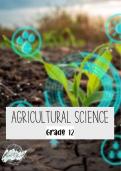Summary
Summary Grade 12_Agricultural Sciences Summaries
- Course
- Agricultural Sciences
- Institution
- 12th Grade
Get your hands on the Grade 12 Agricultural Sciences Workbook, the ultimate study guide for agricultural sciences students. This comprehensive set of notes includes all the key information and concepts needed to master the Grade 12 curriculum. Whether you're looking for past lessons or want to delv...
[Show more]



